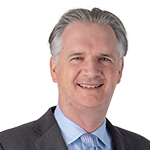Strategic Fixed Income: end of the cycle… are we there yet?
4 minute watch
With the markets finally coming round to the idea of the late-cycle stage in the economies, John Pattullo and Jenna Barnard, Co-Heads of Strategic Fixed Income, share their thoughts on the subject, expanding on the risks and opportunities arising from this theme in 2019.
Key points:
- The key theme in 2019 is based on the question: when and how will the cycle end?
- While the managers believe we live in a much less inflation-prone world, there is a small but unlikely possibility of a sudden acceleration in inflation, leading to aggressive rate hikes by central banks.
- The key opportunity is that it is late-cycle. If proved correct, as the cycle turns, there should be opportunities in quality government and investment grade bonds to reward bond investors.
Video Summary
Key themes likely to shape 2019
The key theme that would impact the financial markets in 2019 will be the answer to the question: is it the end of the cycle? If so, how is it going to end?
2018 has been classically late-cycle (in our mind, of a very long cycle) and hence really a test of is growth going to fade? Was the Trump fiscal expansion a sugar rush or was it something more structural (which we are sceptical about)? Is inflation going to come through (again, we are pretty sceptical about that)? Finally, what is going to happen to global demand, growth and inflation respectively, and hence, which asset class do you want to position for accordingly?
Opportunities and risks for bond investors
The key risk facing bond investors in 2019 is a sudden acceleration in inflation, either consumer price inflation or wage inflation, to which central banks would react aggressively. In our mind, we think we live in a much less inflation-prone world. With the oil price coming off at the end of 2018 (helpful for reducing headline inflation), the risk lies more with central banks that are itching to normalise interest rates by raising them to levels that they consider more normal, in order that they can cut them in the next recession. So far, the only ones that have managed to do this are the US Federal Reserve and the Canadian central bank. For many reasons, other central banks in the developed world have struggled to raise interest rates.
The main risk facing credit (corporate bond) markets is that we are in a late-cycle phase. There has been a huge deterioration in the quality of companies that have been raising debt. Other indicators include the amount of debt that they have raised and the use of proceeds. If we, and the markets, are right in indicating that it is very late-cycle, then credit will suffer in the next asset price correction.
Yet, being late-cycle also presents opportunities. This phase is the most difficult environment for a bond investor because credit spreads move wider (credit spreads tend to lead the equity market peak) and bond yields and duration fluctuate making it harder to make money. But when the cycle does turn down, in the next phase bond investors can make reasonable returns though investing in quality government and investment grade bonds.
Approach and outlook for 2019
Throughout 2018, we were working under the assumption that it is late-cycle — witness the oil price melting up, lack of breadth in the equity market, the flatness of yield curves in the government bond market, credit spreads beginning to widen and real yields spiking higher. Every asset class that we looked at was ticking the late-cycle check list. With the equity market sell-off and the oil market crashing in October, we believe we received further confirmation that it is ‘later’ late-cycle.
This fact requires a degree of patience and perspective by all — investors and clients. For a while, cash would outperform and short duration bonds would outperform. Later, with the correlations with equities potentially falling, bond yields would start falling as well. And as the peak in rates is realised by the markets, there should be opportunities to increase duration in quality bonds and make capital gains. There may be a rally into Christmas in equity markets, which may drive up bond yields. If that is so, we will probably extend duration because we think this sugar high is not going to last as growth and inflation have peaked.
As portfolio managers we have to position ourselves and our clients accordingly, waiting to get the rewards as and when they come. It is just that sometimes you need to be a little bit more patient than maybe you thought you had to be.
Recorded on 7 November 2018
Notes:
Bond yield: the level of income on a security, typically expressed as a percentage rate. Note, lower bond yields mean higher bond prices and vice versa.
Credit market: a marketplace for investment in corporate bonds and associated derivatives.
Credit spread: the difference in the yield of a corporate bond over that of an equivalent government bond.
Duration: how far a fixed income security or portfolio is sensitive to a change in interest rates, measured in terms of the weighted average of all the security/portfolio’s remaining cash flows (both coupons and principal). It is expressed as a number of years. The larger the figure, the more sensitive it is to a movement in interest rates.
Inflation: the rate at which the prices of goods and services are rising in an economy. The CPI and RPI are two common measures.
Late-cycle: asset performance is often driven largely by cyclical factors tied to the state of the economy. Economies and markets are cyclical and the cycles can last from a few years to nearly a decade. Generally speaking, early cycle is when the economy transitions from recession to recovery; mid-cycle is when recovery picks up speed while in the late cycle excesses typically start to build, growth slows, wages start to rise and inflation begins to pick up. It is often in the late stage that investors become overconfident.
These are the views of the author at the time of publication and may differ from the views of other individuals/teams at Janus Henderson Investors. References made to individual securities do not constitute a recommendation to buy, sell or hold any security, investment strategy or market sector, and should not be assumed to be profitable. Janus Henderson Investors, its affiliated advisor, or its employees, may have a position in the securities mentioned.
Past performance does not predict future returns. The value of an investment and the income from it can fall as well as rise and you may not get back the amount originally invested.
The information in this article does not qualify as an investment recommendation.
Marketing Communication.
Important information
Please read the following important information regarding funds related to this article.
- An issuer of a bond (or money market instrument) may become unable or unwilling to pay interest or repay capital to the Fund. If this happens or the market perceives this may happen, the value of the bond will fall.
- When interest rates rise (or fall), the prices of different securities will be affected differently. In particular, bond values generally fall when interest rates rise (or are expected to rise). This risk is typically greater the longer the maturity of a bond investment.
- The Fund invests in high yield (non-investment grade) bonds and while these generally offer higher rates of interest than investment grade bonds, they are more speculative and more sensitive to adverse changes in market conditions.
- Some bonds (callable bonds) allow their issuers the right to repay capital early or to extend the maturity. Issuers may exercise these rights when favourable to them and as a result the value of the Fund may be impacted.
- If a Fund has a high exposure to a particular country or geographical region it carries a higher level of risk than a Fund which is more broadly diversified.
- The Fund may use derivatives to help achieve its investment objective. This can result in leverage (higher levels of debt), which can magnify an investment outcome. Gains or losses to the Fund may therefore be greater than the cost of the derivative. Derivatives also introduce other risks, in particular, that a derivative counterparty may not meet its contractual obligations.
- When the Fund, or a share/unit class, seeks to mitigate exchange rate movements of a currency relative to the base currency (hedge), the hedging strategy itself may positively or negatively impact the value of the Fund due to differences in short-term interest rates between the currencies.
- Securities within the Fund could become hard to value or to sell at a desired time and price, especially in extreme market conditions when asset prices may be falling, increasing the risk of investment losses.
- Some or all of the ongoing charges may be taken from capital, which may erode capital or reduce potential for capital growth.
- CoCos can fall sharply in value if the financial strength of an issuer weakens and a predetermined trigger event causes the bonds to be converted into shares/units of the issuer or to be partly or wholly written off.
- The Fund could lose money if a counterparty with which the Fund trades becomes unwilling or unable to meet its obligations, or as a result of failure or delay in operational processes or the failure of a third party provider.

